Abstract
The partitioning of adsorbed P between labile and non-labile pools by soils is fundamental to the residual effect of fertilizer-P added to soils. The main objective of the study was to determine the partitioning of adsorbed P between the labile and non-labile phases by some benchmark soils of northeast Brazil for which is little is known. Surface and subsurface samples of several soils: Non-Calcic Brown soil and Planosol (Haplustalfs), Cambisol (Ustropept), Lithosols (Orthents) and Alluvial soil (Tropaquept) were equilibrated with varying concentrations of KH2PO4. The readily exchangeable portion of the adsorbed P was determined by anion exchange resin (AER). Considerable hysteresis was observed between adsorbed P and AER-P. To quantify the extent of the hysteresis, a critical P concentration (Pcrit), the amount of P adsorbed at zero desorption by AER, was defined. The Pcrit of the soils averaged across the soil depths followed the order: Non-Calcic Brown soil > Planosol > Alluvial > Cambisol > Lithosol. The Pcrit correlated with clay and oxalate Fe (Feo). The P affinity index (K) estimated by Langmuir adsorption model accounted for 66% of the variance in Pcrit. A sequential extraction with 0.5M NaHCO3, 0.1M NaOH and 11.5M HC1 to remove the labile, moderately labile and non-labile P forms respectively, indicated that between 63 and 99% of adsorbed P was in the labile pool (AER-P + HCO3-P + OH-P), suggesting that the soils might have high potential for residual fertilizer-P responses.
Similar content being viewed by others
References
Agbenin J O and Tiessen H (1994a) Phosphorus transformations in a toposequence of Lithosols and Cambisols from semiarid NE Brazil. Geoderma 62: 345–362
Agbenin JO and Tiessen H (1994b) Effect of soil properties on the differential phosphate adsorption and buffer capacities of soils from northeast Brazil. Soil Sci 157: 36–45
Amer FD, Bouldin R, Black CA and Duke FR (1955) Characterization of soil phosphorus by anion exchange resin and32P equilibration. Plant and soil 6: 391–408
Bache BW and Ireland C (1980) Desorption of phosphate from soils using anion exchange resins. J Soil Sci 31: 297–306
Barrow NJ (1980) Differences amongst a wide ranging collection of soils in the rate of reaction with phosphate. Aust J Soil Res 18: 215–224
Barrow NJ (1985) Reactions of anions and cations with variable charge soils. Adv Agron 38: 183–230
Bar-Yosef B, Kafkalfi U, Rosenberg R and Sposito G (1988) Phosphorus adsorption by kaolinites and montmorillonite. 1. Effect of time, ionic strength and pH. Soil Sci Soc Am J 52: 1580–1585
Cabrera F, De Arambari P, Madrid L and Toca GG (1981) Desorption of phosphorus from iron oxide in relation to pH and porosity. Geoderma 26: 203–216
Evans RL and Jurinak J J (1976) Kinetics of phosphate release from a desert soil. Soil Sci 121: 205–211
Fixen PE and Ludwick AE (1982) Residual available phosphate in near-neutral and alkaline soils. 1. Solubility and capacity relationships. Soil Sci Soc Am J 46: 332–334
Goedert WJ 1983 Management of Cerrado soils: a review. J Soil Sci 34: 405–428
Gunary D and Sutton CD (1967) Soil factor affecting uptake of phosphate. J Soil Sci 18: 167–173
Hingston RJ, Posner AM and Quirk JP (1974) Anion adsorption by goethite and gibbsite. 11. Desorption of anion from oxide surfaces. J Soil Sci 25: 16–26
Hislop IJ and Cooke IJ (1968) Anion exchange resin as a means of assessing soil phosphate status technique: A laboratory technique. Soil Sci 105: 8–11
Muns DN and Fox RL (1976) The slow reaction which continues after phosphate adsorption. Kinetics and equilibrium in some tropical soils. Soil Sci Soc Am J 40: 46–51
Murphy J and Riley JP (1962) A modified single solution for the determination of phosphorus in natural waters. Anal Chim Acta 27: 31–36
Russel JS, Kamprath EJ and Andrew CS (1988) Phosphorus sorption of subtropical acid soils as influenced by the nature of the cation suite. Soil Sci Soc Am J 52: 1407–1410
Ryan J, Hassan HM, Baasiri M and Tabbara HS (1985) Availability and transformation of applied phosphorus in calacreous Lebanese soils. Soil Sci Soc Am J 48: 74–77
Sibbesen E (1978) An investigation of the anion exchange resin method for soil phosphate extraction. Plant and Soil 50: 305–321
Smillie GW, Curtin D and Syers JK (1987) Influence of exchangeable calcium on phosphate retention by weakly acid soils. Soil Sci Soc Am J 51: 1169–1172
Stewart JWB and McKercher RB (1982) Phosphorus cycle. In: Burns RG and Slater JH (eds) Experimental Microbial Ecology, pp 221–238. Blackwell Scientific Publ., Oxford, London
Taylor RW and Ellis BG (1978) A mechanism to describe P adsorption on soil and anion resin surfaces. Soil Sci Soc Am J 42: 432–436
Vaidyanathan LV and Talibudeen O (1970) Rate processes in the desorption of phosphate from soils by ion exchange resins. J Soil Sci 21: 173–178
Author information
Authors and Affiliations
Rights and permissions
About this article
Cite this article
Agbenin, J.O. Adsorbed phosphorus partitioning in some benchmark soils from Northeast Brazil. Fertilizer Research 40, 185–191 (1994). https://doi.org/10.1007/BF00750464
Received:
Accepted:
Issue Date:
DOI: https://doi.org/10.1007/BF00750464




